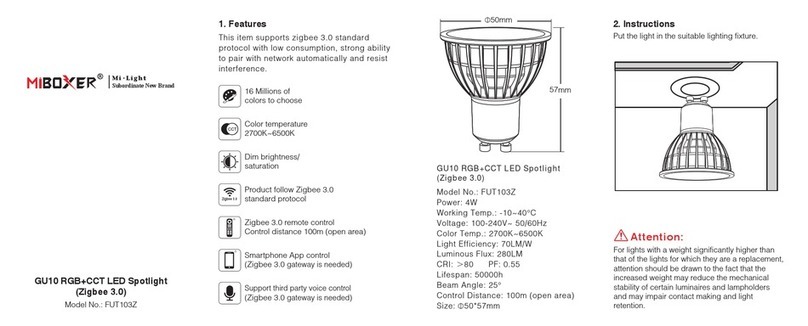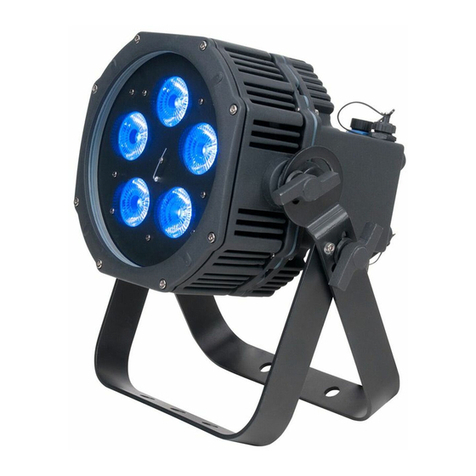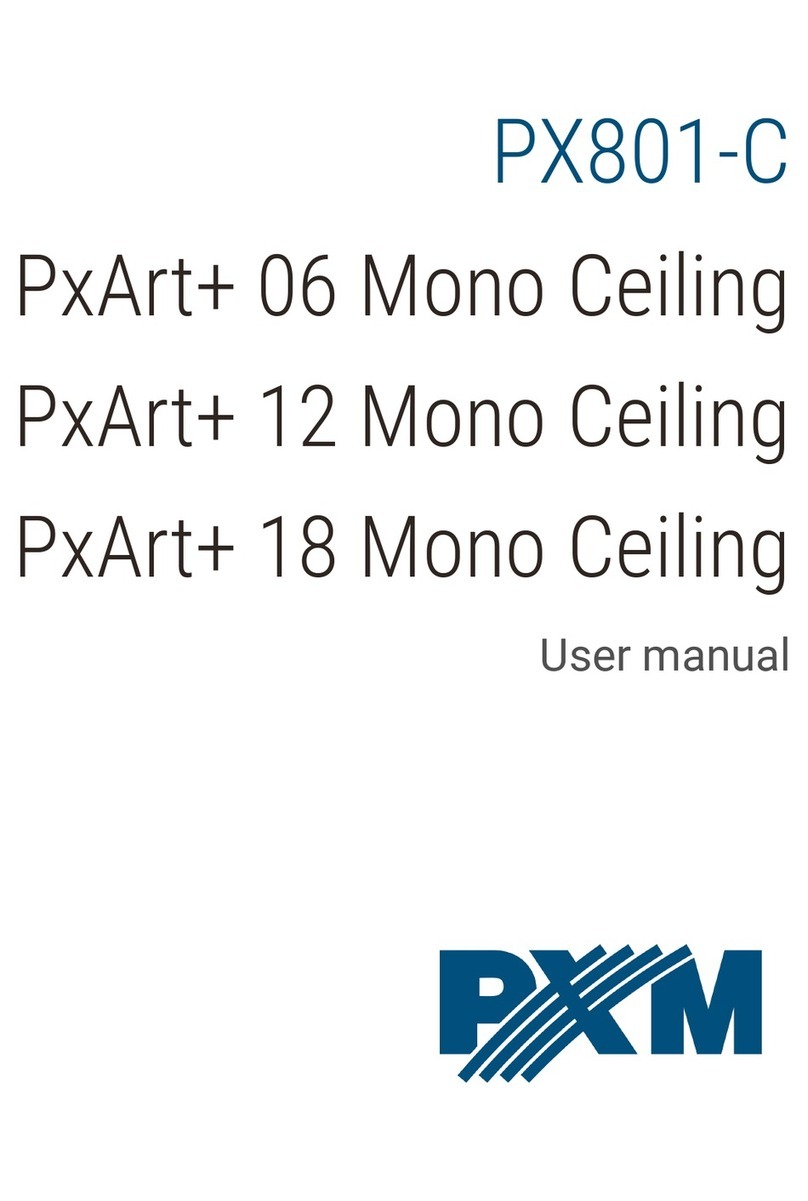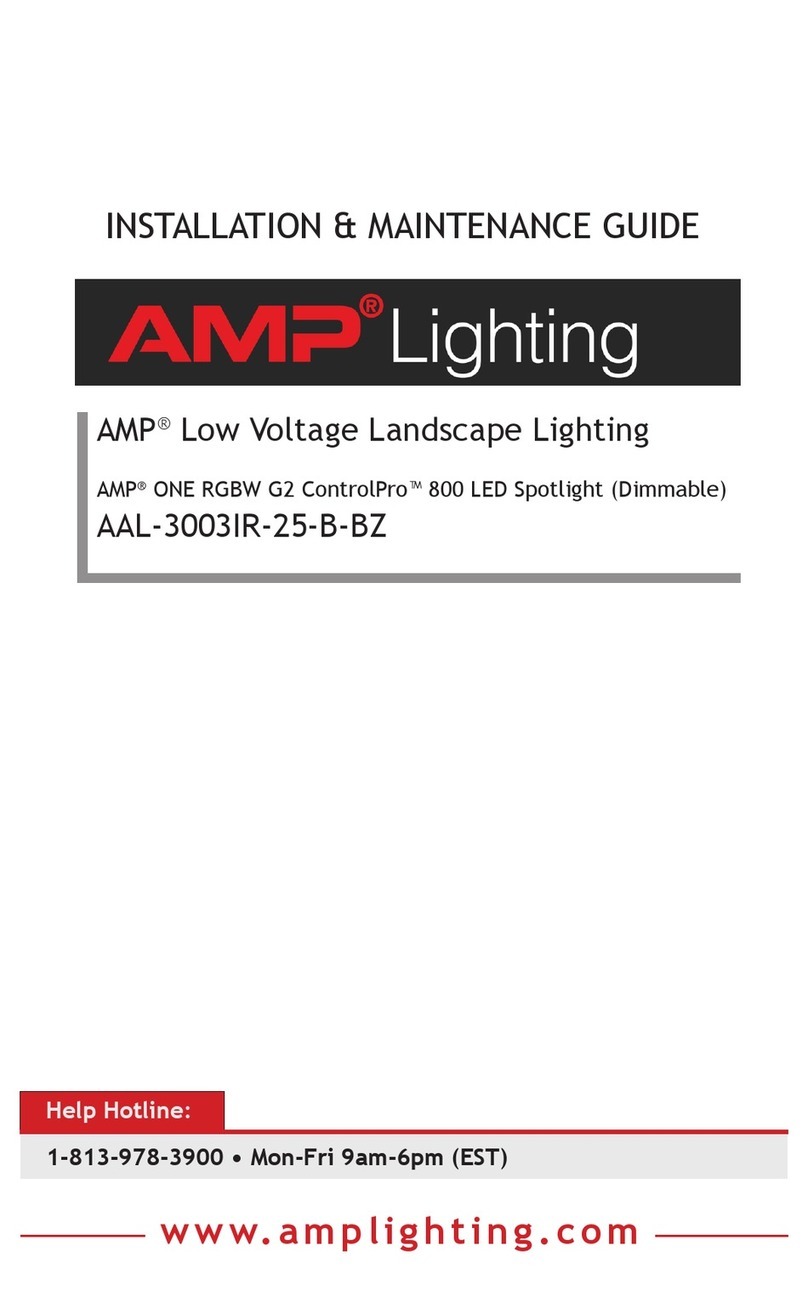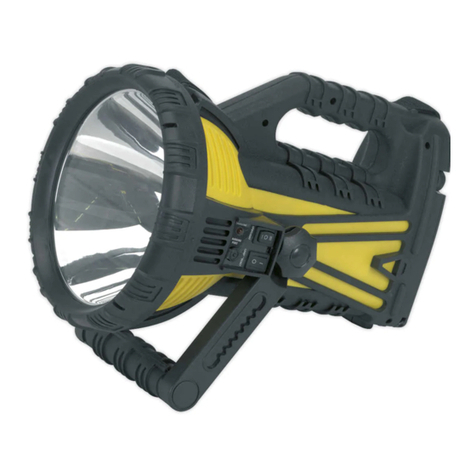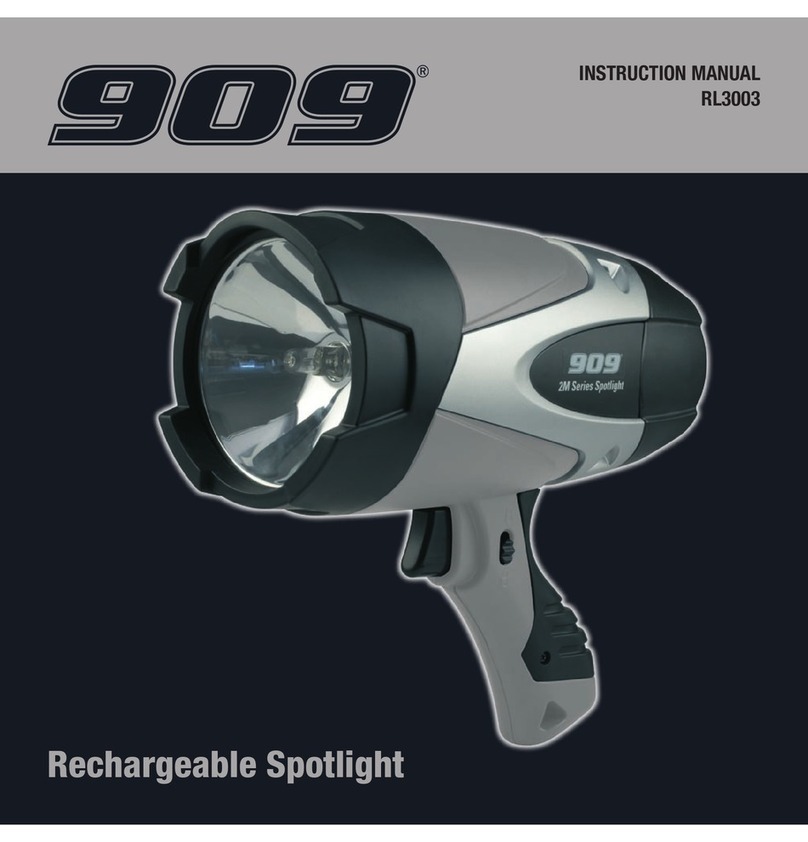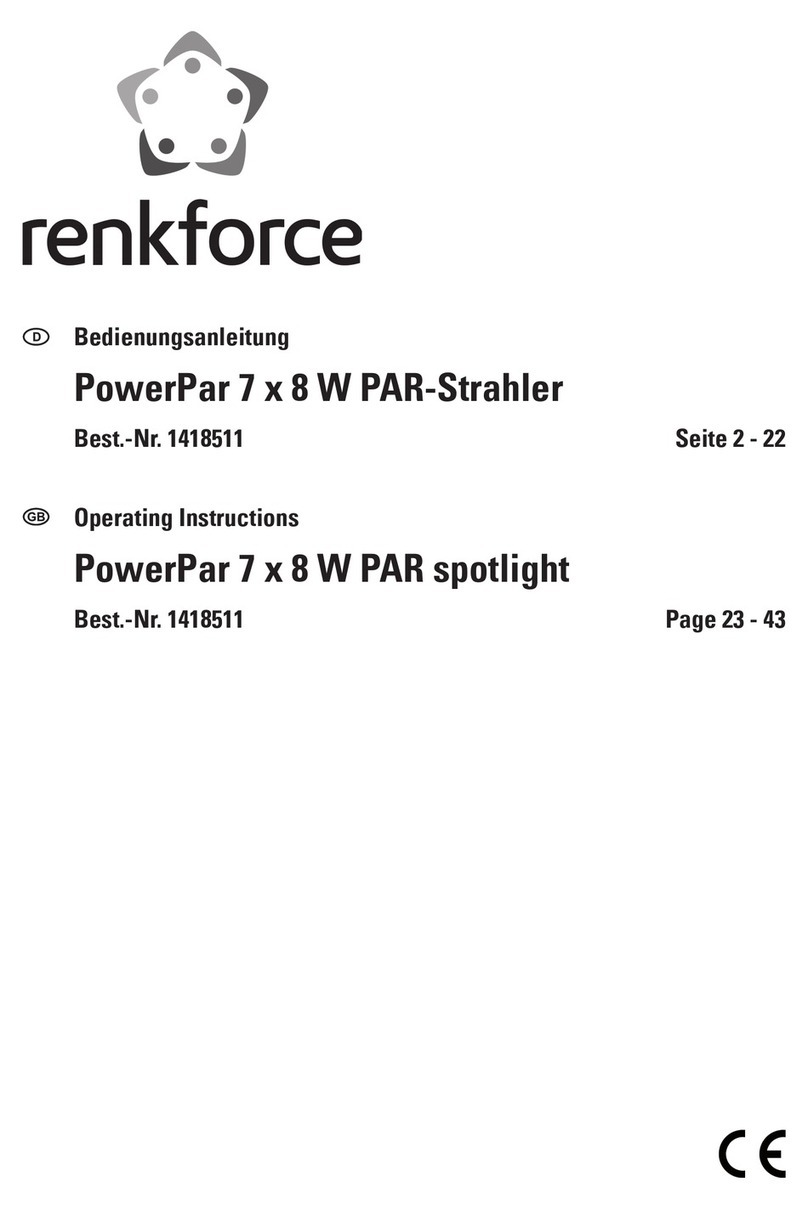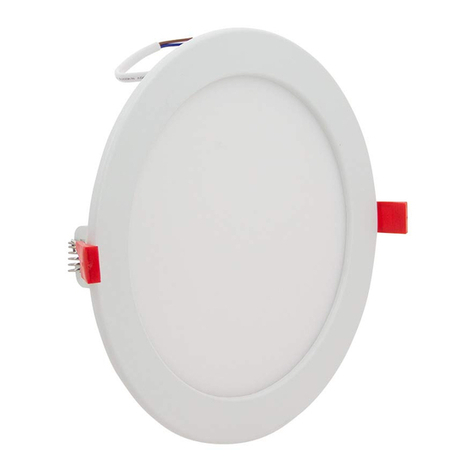Strong Lighting SUPER TROUPER III User manual

FOLLOW SPOTLIGHT
INSTRUCTION MANUAL
SUPER TROUPER III
Rev. March 2018
10533 Chandler Rd, Suite 101 • La Vista,
NE 68128 USA Tel (402) 506-9096 •
www.strong.lighting


PREFACE
THE STRONG SUPER TROUPER®III SYSTEM consists of a direct current xenon
lamphouse and an advanced-design lens mechanism constructed and aligned on acommon base rail.
Operator controls are easily accessible. The spotlight head includes asix-color, self-canceling color
boomerang, and mounts to acollapsible base stand and yoke assembly. Aswitching type, solid-state xenon
power supply with akeyed quick-disconnect lamphouse cable receptacle completes the follow spotlight
system.
ONLY POWER SUPPLIES manufactured by Beamlight, LLC (dba Strong Lighting)
can be used with the xenon spotlight. Current level adjustments (DC output to the xenon bulb) are
made at the power supply by means of output potentiometer. For detailed information
regarding installation and operation of the xenon power supply, see the instruction manual furnished
separately.
THE XENON LAMPHOUSE utilizes a deep ellipse dichroic metal reector designed to
operateinaxedpositionwithahorizontallymountedxenonlampasthelightsource.A solid-stateDC
PulseIgniteris included that requiresnoACcontrolcircuit.Acoatedglassheatlterislocatedatthefront
openingofthelamphousetoreduce the radiant heat at the optical system and color boomerang.
THE LAMPHOUSE INSTRUMENT PANEL is equipped with aDC ammeter and running
time meter. The ammeter continuously displays the operating DC current, and pressing the VOLTS/AMP
rocker switch will momentarily indicate the DC voltage at the arc. The hour meter records the operating
hours of the xenon lamp. The lamp is ignited and extinguished through use of the LAMP rocker switch
mounted on the instrument panel.
ONLY XENON LAMPSdesigned for horizontal operation should be used in this spotlight.
The presently approved ratings for bulbs used in this spotlight are 1600, 2000, 2500 and 3000 watt,
type “HS.” See the listing in this manual for the approved types and necessary adapters.
ADJUSTMENTCONTROLSforpositioningthexenonlampinsidetheellipticalreector
are located above the instrument panel at the rear of the lamphouse. The adjustments control the horizontal,
vertical, and focal position of the lamp.
THE LAMP BLOWERS, internally wired in the follow spot,operate on 115 V.AC
and are required to keep the seals on the lamp at asafe operating temperature. These blowers will
operate continuously until power is turned off at the main line switch to the xenon power supply.Operation
of the blowers to cool the lamp after aperformance will not be recorded by the hour meter. The Super
Trouper III lamphouse, when using a factory-approved, ozone-free xenon lamp,requires no external exhaust
system.
AN ARC STABILIZATION MAGNET, as required by the lamp manufacturers for
the operation of all size lamps,it ismountedtothebaseofthelamphousebelowthereector. The SOUTH
pole of this permanent magnet is dabbed with paint, and must be pointed toward the left (non-operator)
side of the lamphouse.
ST3/001

PREFACE (continued)
THE LAMPHOUSE is supplied with a13 foot (4 meter) cable assembly containing the
two DC leads, the ground wire, and all AC control leads. The cable assembly is terminated with a
multiple pin, keyed MS connectors which mate to receptacles on the xenon power supply cabinet. The
AC hook-up to the xenon power supply is detailed in the power supply manual; AC connectors
must comply with all local electrical codes.
THE OPTICAL SYSTEM incorporates anewly-designed lens mechanism. Spotlight
operators familiar with earlier type Strong spotlights are urged to study the section following in this
manual entitled OPERATION OF THE OPTICAL SYSTEM and to practice the operation of the Super
Trouper III prior their rst performance. The spot size control (“trombone”) handle is drawn back to
“spot” and pushed forward to “ood,”which isthe reverseof earliertype Strongoptical systems.The
spotedgeisfocusedbyrotatingthefocus knobs located behind the boomerang on the left of the optical
system.
FADE-OUT, CHOPPER, AND IRIS CONTROLS are positioned in the same
congurationas earlier Strong spotlights. All optical system controls are accessible for right- or left-hand
operation. The color boomerang is easily reversed to position the color arms on either side. Operation of
the self-canceling boomerang remains unchanged, and standard Strong nine-inch gel frames are used.
WHEN TRANSPORTING the spotlight, it is recommended, but not necessary, that
the xenon lamp be removed and placed in its original shipping carton with the cover on the lamp to
insure against breakage. The lamp,after cooling to room temperature, may remain mounted in the
lamphouse if moving the spotlight from one position to another within the arena or auditorium.
Reasonable care should be exercised; breakage caused by handling is not covered by the xenon lamp
warranty. Transportation of the Super Trouper III from venue to venue with the lamp installed is
permitted so long as the road case that the follow spot is stored in is designed to protect the fixture
and provide a cushioned ride.
ST3/002

ST3/003
1. Cover, Lamphouse Compartment 9. Mounting Bracket, Leveling Foot
2. Fade-Out Control Lever 10. “T” Bolt, Folding Leg
3. Masking Blade Control Lever 11 Horizontal Swing Friction Adjust
4. Iris Control Lever 12. Horizontal Tilt Friction Adjust
5. Cover, Optical System 13. Spot Size Control (Trombone) Handle
6. Disc Housing, Color Boomerang 14. Lifting Strap
7. Color Selector Lever, Boomerang 15. Hand Rail
8. Height Adjusting Pin 16. Arc Viewing Port

LAMPHOUSE - POWER SUPPLY
Interconnection Diagram
LAMPHOUSE
(Connections Pre-wired)
MS CONNECTOR
Pin Wire No,
A DC-
B DC+
C 2
D 3
E 4
F 5
G 6
M Grnd
Lamphouse
Cable Assembly
XENON
POWER
SUPPLY
MS Connector (pre-wired)
DC+
DC-
SYSTEM MUST BE GROUNDED
All wiring must conform to local codes;
shield lamphouse cable in conduit if
required.
ST3/004

INSTALLATION AND SETTING UP SPOTLIGHT
THE SUPER TROUPER III is shipped in sections which must be assembled. Lifting straps
mounted to the yoke pivot studs (see Figure 6, Item 2) are designed to bear the weight of the spotlight and base.
Thispermitsassemblingthespotlightontheoorandlaterhoistingittoanoverheadspotlightposition.
THE FOLDING BASE ASSEMBLY is shipped collapsed, and requires only folding the base
legs down and pinning the legs using the four T-bolts (Figure 6, Item 17) supplied. Screw the four leveling
feet and locknuts (Figure 6, Item 15) into the brackets at the end of each leg.
WHEN INSTALLED in apermanent location, the leveling feet and casters must be removed,
and the holes in the base leg brackets used for hardware (user-supplied lag screws or bolts) to secure the base
totheoororplatform.Ifitisdesiredtohavetheunitportable,whenoperating,thefourlevelingfeetmust be
adjusted down until the entire weight of the spotlight has been shifted from the casters to the leveling feet.
THE INNER TUBE below the support yoke is drilled with three holes to permit adjusting
the height of the spotlight. The three holes are on four-inch centers and will allow an optical height of ap-
proximately53inches,57inches,and61inchesaboveoorleveltotheopticalcenterofthelamphouseand
lens system. Insert the height location pin through the hole in the outer tube of the base column and one of
the holes in the inner tube. The leveling feet may be adjusted through an additional two-inch range.
THE HORIZONTAL PAN and vertical tilt locking knobs are on the right hand (from rear) side
of the yoke assembly.The yoke saddle is marked to indicate FRONT.Tighten both of these locking devices
securely before attempting to place the spotlight head (lamphouse and lens system) on the support yoke.
PLACE THE LAMPHOUSE and lens system on the yoke assembly,with the operator’s side
of the lamphouse (with arc viewing port) to the right side of the yoke saddle, the same as the yoke locking
controls. Line up the four mounting holes in the bottom plate of the support brace with the four slotted
holes inthesaddleoftheyokeassembly.Secureusingthefour5-16/18wingheadscrewsandatwashers.
Aftermounting the color boomerang (see below), loosen the tilt lock and test the spotlight balance at the
desired projection angle. Loosen the (4) wing head screws and slide the spotlight head forward and back in
the slotted holes in the yoke saddle to achieve optimumbalance before nally securing the wing head
screws.
MOUNT THE COLOR BOOMERANG to the front of the optical system with the color arms
facing the desired operating side. Remove the (3) screws from the mounting studs on the front of the optical
system housing. Align the three holes in the boomerang housing to the three mounting studs; open the hinged
front cover to access the mounting holes and secure the boomerang to the studs using the (3) screws.
ATTACH THE LAMPHOUSE CABLE CONNECTORS to the mating receptacles on
the power supply.The power supply connectors are keyed for correct pin align-ment; make certain pins are
seated before tightening the locking ring. DO NOT energize the xenon power supply before the xenon lamp
is correctly installed into the lamphouse.
THE SUPER TROUPER III is wired for operation with the “compact” model xenon power
supply Equipment Type 62000xx and the new B3 Strong Lighting followspot power supply.If
installing the Super Trouper III with an older model or type xenon power supply,aground wire must
be connected to the power supply’s MS connector Pin M. Operation of the Super Trouper III with a
xenon power supply other than a62- or B3 series will void safety listing compliance.
ST3/005

SAFETYPROCEDURES
THE XENON LAMP is highly pressurized. When ignited, the normal operating
temperature of the lamp increases the pressure to alevel at which the lamp may explode if not handled in
strict accordance to the manufacturer’s operating instructions. The lamp is stable at room temperature, but
may still explode if dropped or otherwise mishandled.
REFER ALL LAMP REPLACEMENT and service to QUALIFIED PERSONNEL with
adequate protective clothing (face shield, clean cotton gloves, welder’s jacket). For routine lamphouse service,
observe the following rules:
1. Allow the lamp to cool to room temperature before opening the lamphouse. Put on protective clothing
described above.
2. De-energize the xenon power supply at the AC source before opening the lamphouse compartment.
3. When possible, encase the lamp in its protective cover when cleaning or servicing the lamphouse
interior. The lamp,when outside the lamphouse, must be encased in the cover.
4. Clean the lamp after it has cooled to room temperature. Do not touch the quartz envelope of the
lamp; ngerprintswillburninandcreatehotspotswhichmayshortenbulblife.Ifngermarksare
made, they should be carefully removed with isopropyl alcohol and cotton prior to operation.
5. Never view an ignited lamp directly. BLINDNESS OR PERMANENT EYE DAMAGE MAY BE
INCURRED.
6. Use only xenon lamps designated as OZONE FREE.
7. Maintain the lamphouse blowers in good operating condition. Keep the blower inlets clean for
unrestrictedairow.
8. Toinsure maximum lamp life, operate the lamphouse blowers for at least ten minutes after extinguish-
ing the lamp.
9. If returning alamp for warranty adjustment, pack it in its original shipping container. Complete and
return all required warranty information.
10. Dispose of expired lamps that are beyond warranty in the following manner: Wrap the bulb tightly
in several layers of canvas or heavy cloth. Place it on ahard surface and shatter the envelope with a
sharp hammer blow. DO NOT place an un-shattered bulb in an ordinary refuse container.
11. DO NOT PERMIT UNAUTHORIZED PERSONNEL TO PERFORM OR ATTEMPT ANY PHASE
OF XENON LAMP HANDLING OR SERVICE.
Anode End Cap
Envelope
Anode Pin
Seal Anode
Cathode
Seal
Cathode End Cap
Trigger Wire
Cathode
Pin
ST3/006

THE ABOVE XENON LAMPS are designated OZONE FREE, and replacement lamps
other thantheabovemustbecertiedbytheirmanufacturerasbeing100%interchangeable.Thewarranty
onthexenon bulb supplied is administered by the lamp manufacturer and is separate from the spotlight
warranty issued by Strong Lighting.Retain the warranty documentation packed with the xenon lamp.
WHEN ORDERED for 1600 watt operation, the adapters required to install these smaller bulbs
in the Super Trouper III lamphouse are supplied in the accessory kit. The front bulb support in the 1600 watt
lamphouses is acast yoke (65117000) which holds the stem of the cathode adapter. Aretainer plate
(65151000) and two thumb screws (65152000) clamp the stem of the cathode adapter into the yoke.
THE 2000/2500/3000 WATT type “HS” lamp mounts into the lamphouse without
adapters. The front lamp support for these lamps(83747000) is acushioned ring which encircles the
cathode (-) end cap of the bulb. The negative contact (24269000) clamps either on the end of the
1000/1600 watt cathode adapter (as shown on following page) or mounts directly to
the .312" (8mm) cathode pin of the 2000/2500/3000 “HS” lamp.Atrigger wire, encircling the lamp
envelope and attached to the end cap (as illustrated on the facing page), must be present.
IF IT IS DECIDED subsequent to the initial installation to change lamp wattages, it is
necessary to verify that the original xenon power supply will operate the replacement lamp throughout its
range. The older 115 volt power supply is not recommended for use with a2000 watt lamp,and should be
replaced with a220 volt, Type 62- or B3 unit. Make certain that the correct front lamp support is
installed; 65117000 Yoke for 1600 watt, or 83747000 Ring Support for 2000 or higher watt lamp.
The rear lamp support collet (24266000) accommodates either the anode pin of the 2000/2500/3000
watt “HS” lamp or the stem of the anode adapter.
ST3/007
LAMP INSTALLATION
CAUTION: OBSERVE ALL SAFETY PROCEDURES. Put on protective face mask. Wear cleancotton
glovestopreventmarkingthequartzenvelopeofthebulbwithngerprints.Turnthecircuitbreaker on the
side of the xenon power supply cabinet OFF.
DISMOUNT THE LAMPHOUSE ACCESS COVER by removing the two phillips head
screwsandlockwashers;(1)attherearbulkheadand(1)atthefrontbulkhead.Open thekeylockafterrst
removing the hex head security screw. Do not misplace the security screw.
THE SUPER TROUPER III SYSTEM is shipped from the factory with acompatible xenon
power supply. The desired lampwattage and desired input voltage of the spotlight system shipped is
speciedby the customer when placing the original equipment order. Four wattages are available: 1600,
2000, 2500 or 3000watt. Lampsapproved for use in the Super Trouper III include:
Ushio Nominal LIMIT
Wattage
1600 CSX16S 65 A. 75 A.
2000 CSX20SC 75 A. 85 A.
2500
3000
OSRAM
XBO1600W/HS OFR
XBO2000W/HS OFR
XBO2500W/HS XL OFR
XBO3000W/HS XL OFR
LTI
LTIX-1600W-HS
LTIX-2000W-HS
LTIX-2500W-HS
LTXI-3000W-HS 85 A.95 A.
95 A.105 A.

XENON LAMP INSTALLATION
NO ADAPTERS REQUIRED FOR 2000 WATT TYPE “HS” LAMP
See Parts List, Figure 2 for 2000 watt lamp mounting illustration
ST3/008
Configuration for 1600W Operation
Note: The reflector is factory laser aligned and should not be adjusted under normal
circumstances. Only when a new reflector is installed is adjustment required.

1600 Watt Lamp Installation
ASSEMBLE THE REQUIRED ADAPTERS to the 1600 watt lamp as illustrated prior
to inserting the lamp into the lamphouse. Be very careful not to apply any mechanical strain to the
quartz envelope when installing adapters.
SCREW THE THREADED CATHODE ADAPTER (24270000) onto the lamp studso it
seatsrmlyagainsttheshoulderofthecathode(-)endcap.Slipthecorrectbrassanodeadapterwithset
screw over the stud of the positive end cap in contact with the shoulder of the anode (+) end cap. Tighten
allthreadedfastenerssecurelytoinsurermmechanicaltandgoodelectricalconduction.
LOOSEN THE THUMB SCREWS on the top of the front lamp support yoke and swing the
retainer plate clear of the yoke. Slide the contact clamp of the igniter lead over the brass socket of the rear
lamp support collet.
REMOVE THE PROTECTIVE COVER from the lamp after putting on the face shield.
DO NOTtouchtheclearquartzenvelopeofthelampwithbarengers.Naturalskinoilswillrapidlyburn
into the quartz and shorten lamp life. The xenon lamp warranty does not cover damage of this nature. Ifthe
quartz is accidentally ngermarked, thoroughly remove the ngerprints with isopropyl alcohol before
igniting the lamp.
INSERTTHELAMPintothelamphouse,betweenthereectorsupportandthefrontofthe
lamphouse.Passtheanode(+)endofthebulbintothereectorandthroughthecenterholeofthereector.
Take care nottotouchorscratchthesurfaceofthereector.
INSERT THE ANODE ADAPTER STEM into the rear support collet. The stem must be
inserted as far into the socket as possible to insure good conduction and to permit full focus travel of the
lamp.Place the cathode adapter stem into the front lamp support yoke, pivot the retaining plate to its
closed position, and tightenboththumbscrews.Usinga9/64"Allenwrench,rmlytightenthesockethead
clampingscrewinthepositive (+) contact to insure agood electrical contact.
INSTALL THE NEGATIVE (-) LEAD CONTACT CLAMP over the end of the cathode
adapter. Slidethe contact up to seat its shoulder rmly against the tip of the cathode adapter.Dress the
negativeleaddirectly in front of the front lamp support yoke to minimize the shadow.Tighten the socket
head clamping screw securely using a9/64" Allen wrench.
2000 Watt or higher Lamp Installation
REMOVE THE PROTECTIVE COVER from the xenon lamp only if necessary.Slide the
contact clamp of the igniter lead over the brass socket of the rear bulb support collet. If the lamp is supplied
by the manufacturer with an anode lead attached, remove the factory-installed anodelead. Remove any
ngermarksfromthelampenvelopewithisopropyl alcohol.
INSERT THE lamp into the lamphouse, passing the anode (+) end through the holeinthe
reector.Handlethelampbythemetalendcapsonly. Pass the anode pin as far as possible to the rear of
the lamphouse to allow clearance between the cathode (-) pin and the front lamp support. Take care
nottotouchorscratchthesurfaceofthereector;donottouchthequartzenvelopeofthe lamp.Slidethe
cathode (-) end cap through the spring-cushioned ring of the lamp shock mount.
ST3/009

2000 Watt or higher Lamp Installation (continued)
NOTE THE TWO NOTCHES at the center hole of the reflector. These notches
allow additional clearance between the grounded reflector and the energized lamp trigger wire.
Rotate the lamp to align the trigger wire with one of these two notches to prevent the trigger wire
from arcing to the grounded reflector.
INSERT THE ANODE (+) PIN of the bulb into the rear support collet. The pin must be
inserted as far into the socket as possible to insure good conduction and permit full focus travel of the lamp.
Makecertainthelamp’striggerwireisalignedtothecenterofeitherreectornotch,andrmlytightenthe
socket head clamping screw. Slide the negative contact clamp over the cathode (-) pin and dress the
negative lead directly in front of the front bulb support to minimize the shadow. Securely tighten the
negative clamp.
AN ALTERNATE (HIGHLY RECOMMENDED)METHOD of installing these lamps is
to dismount the shock mount ring and cushion spring from the front bulb support assembly by removing
the singe socket head screw holding the shock mount ring to the mounting bracket. DO NOT REMOVE
THE MOUNTING BRACKET FROM THE FRONT LAMP SUPPORT. Slide the ring over the cathode (-)
end cap of the lamp,and install the lamp by inserting the anode (+) end cap through thereectorcenterhole
andseatingtheanodepinintotherearsupportcollet.Re-mountthe ring to the base bracket of the front
lamp support using the socket head screw. Secure the anode (+) clamping screw; install and tighten the
cathode (-) contact clamp.
THE SOCKET HEAD SCREW which mounts the lamp support ring to its support bracket
must be tightened securely enough to clamp the upright bulb support ring in avertical (90°) position and
prevent its tilting forward or back as the bulb is focused. The end cap of the lamp should touch only the
coils of the shock mount spring to allow the lamp to slide forward and back with aminimum of friction and
no stress on the envelope.
All Lamp Wattages
INSERTTHESTRIPHEATFILTERintothebracketinfrontofthexenonlamp.Thislter
is anarrow glass strip that covers only the center portion of the beam. One surface of the glass is coated,
and marked “XX” and/or imprinted “This Surface Toward Lamp.” The coated glass surface must face the
lamp or damaging radiant heat energy will be transmitted to the optical system. DO NOT operate the
spotlight with theglassstripheatltermissing, reversed or in a deteriorated state.
CHECK THE ARC STABILIZATION MAGNET mounted to an “L” bracket below the
reector. The SOUTH pole of the magnet is marked with paint, and should be pointed toward the non-
operator side of the lamphouse (left side, as viewed from rear). If the magnet is reversed, the arc will burn
high on the face oftheanodeelectrode,creatingsevere lightickerand causing ignitionproblems. This
magnetisrequired for 2000 watt or higher operation, and is in no way detrimental to the operation of 1600
watt bulbs.
REMOVE THE PROTEVTIVE COVER from the xenon lamp.Do not ignite the lamp
with the cover on the lamp.Retain all protective materials supplied with the lamp and store in asecure
location at or near the spotlight.
REPLACE THE LAMPHOUSE COVER. Replace and tighten all (3) Phillips
head retaining screws and washers. Secure the key lock and install the security screw. The lamphouse
cover must be correctly installed and secured to close the cover interlock switches and enable ignition
and operation.
IT IS RECOMMENDED to establish aroutine for periodically checking all electrical
connections for tightness, particularly those at the lamp.Aloose connection in the DC circuit may cause
overheating of contacts and leads, and may damage or destroy the lamp.The xenon lamp warranty does not
allow credit for heat-related damage of this nature
ST3/010

LAMP ALIGNMENT & LAMPHOUSE OPERATION
PRIOR TO OPERATING THE SPOTLIGHT, verify the following conditions:
PThe protective cover has been removed from the xenon bulb.
PThestripheatlterisinstalledwiththecoated surface facing the lamp.
PThe lamphouse access cover is in place and secured using both Phillips
head screws; key lock secured and hex head security screw installed.
SEE THE PRECEDING “LAMP INSTALLATION” SECTION for instructions detailing
the above. Failure to remove the lamp's protective cover will damage or destroy the xenon lamp.Amissing
or reversed heat lter will allow radiant heat damage to the optical mechanism and lens system. The
lamphousecovermust be installed correctly and secured to actuate all interlock switches and permit lamp
ignition.
ENERGIZE THE XENON POWER SUPPLY by switching the circuit breaker on the side
panel ON. The lamphouse blowers will start and initiate lamp cooling. The lamp blowers will operate
continuously until the xenon power supply is de-energized.
PLACE THE LAMP SWITCH in the ON position and the lamp will ignite. Allow afew
minutes for the current to stabilize, and read the lamphouse ammeter. The lamp must be operated within
the currentrangespeciedbythelamp manufacturer.Therangesforthexenonlampusedareasfollow:
Nominal DO NOT
Wattage Current EXCEED
1600 65 A. 75 A.
2000 75 A. 85 A.
2500
3000
85 A.
95 A.
95 A.
105 A.
ADJUST THE XENON POWER SUPPLYas instructed in the power supply manual for the
correct operating current. Anew xenon lamp is normally operated at “nominal” current. After prolonged
use, the light output will decrease because of the quartz envelope darkening, aresult of normal lamp aging.
At this time, the current output setting may periodically be increased to compensate for bulb aging, but do
not,at any time,exceedthemaximumcurrentlevelspecied. This adjustment over time is not necessary
with the new B3 type ballast as it is a constant power device and will automatically compensate for lamp
changes.
DISMOUNT THE COVER PLATE located above the lamphouse instrument panel by
removing the three Torxsecurity head screws (use the Torx driver provided in the accessory kit).This
exposesthecontrolmechanismforadjusting the position of the xenon lamp.
THE CENTER SECTION of the control is athreaded member that focuses the lamp in
relation tothereector.Turningthisadjustmentmovesthelamponthehorizontalplane,intooroutofthe
reector.Rotating this section clockwise moves the lamp away fromthereector.Thesmallknurledscrew
to the upper left of this section can be tightened to lock the focusing mechanism in place after the
lamp alignment procedure has been completed.
ST3/011

THE TWO LARGE THUMB SCREWS to the left and right of the focusing control secure
the horizontal and vertical position of the lamp.These two large thumb screws are spring-loaded to provide
adegree of friction against the bulkhead section of the control mechanism.
Focus Control
Focus Lock Screw
Thumb Screw
THEFOLLOWING METHODisrecommendedtopositionthexenonlampinsidethe
reectorin order to project the best light to the stage.
REMOVE THE PROJECTION LENS (item 25, figure 3). To do this you will have to
remove the front lens cover on the operator side. Make note of the directional arrows on the lens.
CENTER THE LAMP ADJUSTMENT CONTROLS. Loosen the two thumbscrews and
center the assembly into the middle of its travel left and right and up and down.
SLIDE THE SPOT SIZE CONTROL HANDLE (“trombone”) back to its stop at the the
rearmost position to project the smallest spot possible. Place the iris, choppers, and dimming controls in
their full openpositions. Project the spot to a wall or similar at perpendicular surface opposite the
spotlight. The image you should see is of the lamp's anode and the front lamp support. The image will be
upside down.
TURN THE CENTER “FOCUS CONTROL” section of the lamp adjustment control, as
illustrated above, fully clockwise until asmall dark spot is projected on the wall (Spot “A”). At this point,
the lamp is defocused at its extreme forward position. Then rotate the focus control counterclockwise until
acenter“hot”spotisdened(Spot“C”). Make sure the image grows and shrinks evenly and is centered.
CENTER FRONT OF LAMP. If at this point the image is not centered you need to adjust
the front of the lamp. Note the issue, turn off the lamp. Open the lamphouse and access the front lamp
mounting bracket. Verify that the Shock Mount Ring is positioned perfectly vertical and that the clamping
screw attaching the ring to the mounting bracket is tight. Loosen the lower screw only and adjust the
bracket to the left or right as indicated by the position of the dark spot. You many have to also adjust the
height. The end goal is to have your light centered. Remember that the lamp is hot and caution must be
exercised while adjusting the front lamp bracket.
Spot “A” Spot “B” Spot “C”
ST3/012
LAMP ADJUSTMENT CONTROLS

AFTER THE SPOT is correctly positioned, verify that the lamp is at the optical centerline,
by turning the focus control clockwise to again project Spot “A.” The dark spot should remain centered in
the spot projection as shown.
REPLACE PROJECTION LENS and replace front lens housing. Be sure to replace the
lens into the original orientation shown by the direction arrows.
ROTATE THE LAMP FOCUS CONTROL (center section) to obtain the brightest light
with even, at light distribution (Spot “B”). To sharpen the edge of the spot, rotate the spot ne focus
control(largeknurled knob) located immediately behind the color boomerang.
ASECOND METHOD of aligning the xenon lamp is to project the spot to the stage, and
using the lamp adjustment controls, obtain a“hot” spot in the projected spot. Center this “hot” spot in the
projected spot by moving the entire control section around the two thumb screws. Once the “hot” spot is
centered, or slightly above center in the projected spot, lock the adjustment control in position with the two
thumb screws and rotate the focus control (center section) to obtain abright spot with an even distribution of
light. Tosharpen the edge of the spot, rotate the knurled focus control knob located on either side of the lens
mechanism.
THIS LAMP POSITIONING ADJUSTMENT should not be disturbed until the xenon lamp
is either rotated or replaced. At this time it will be necessary to repeat the above lamp alignment procedure.
REPLACE THE REAR COVER PLATE over the lamp adjustment control mechanism.
Secureinplacewiththe(3)Torx securityheadscrews.
BECAUSE OF MANUFACTURING TOLERANCES and normal lamp aging, it may
be necessary to operate one lamp at slightly higher or lower current than others to obtain equal light
balance between two or more spotlights. These current adjustments are made at the xenon power supply.
TO EXTINGUISH THE ARC, place the LAMP switch in the OFF position. The blowers
in the lamphouse will continue running until the xenon power supply is de-energized. Allow the blowers to
operate and cool the lamp for at least ten minutes after extinguishing. This measure is required to
comply with the lamp manufacturer’s warranty conditions.
TO PROLONG LAMP LIFE, and to encourage rapid lamp starts, it is recommended
to douse out using the fade-out blades rather than extinguishing the lamp during “dark” periods
between cues. Multiple ignition pulses and “warm” re-starts consume more power and cause more
lamp electrode wear than sustained operation. While repeated ignitions are frequently unavoidable, and
within design parameters, a(20) minute delay between ignitions is desirable.
COMPLY WITH THE LAMP MANUFACTURER’S INSTRUCTIONS regarding rotation
of thexenonlampatspeciedintervals.Torotatethelamp,loosenboththepositiveandnegativeclamps.
Grasp-ingthemetalendcaps,rotatethebulb180°andalignthetriggerwiretotheoppositereectornotch.
Securelyre-tighten both clamps.
RETURN LAMPS upon which awarranty claim is being made to the theatre equipment
dealer through whom the unit was purchased. Pack the lamp in its original shipping carton with the
protective cover over the lamp.Complete and enclose all warranty forms supplied by the lamp
manufacturer. Warranty credit will not be allowed if the lamp failure is related to mishandling, incorrect
installation, faulty supporting equipment, or abuse.
ST3/013

HANDLING THE SPOTLIGHT
THE SUPER TROUPER III can be operated from either side. Generally, the best
position for the operator to stand is near the center of the spotlight, on the right hand side. The angle of tilt
and the size or location of the porthole may alter the position for the most convenient operation. Each
operator will, after afew minutes of operation, generally develop his or her own system and position for
operating the unit.
POSITION THE COLOR BOOMERANG with the color arms facing the desired operating
side. The boomerang housing can be reversed by removing the three mounting screws, removing and
reversing the boomerang, and re-mount using the (3) mounting holes on the opposite side of the housing. It
is advisable to checkthesequenceofcolorltersandtoplacethemoredensecolors(red,green)inthefront
positionsoftheboomerang (furthest away from the arc). See the following OPERATION OF THE COLOR
BOOMERANG section for detailed instructions.
THE HORIZONTAL PAN and vertical tilt tension adjustment levers are located on the
yoke assembly.Each can be separately set to give the desired degree of friction on spotlight swing, from
complete release to total lock-down, to suit the spotlight’s application and the individual operator.
THE LENS SYSTEM “ZOOM” BRAKE, which controls the degree of force required to
slide the spot size control handle (“trombone”), is located on the outrider of the movable projection lens
carriage. Alternately tightening or loosening the nylon brake tension screw will increase or decrease
the force required to operate the spot size control handle. Requirements may vary, and the braking
can be adjusted to both accommodate the angle of tilt and to suit the individual operator. See the
following OPERATION OF OPTICAL SYSTEM section for details regarding accessing and setting the
friction brake. The lens mechanism housing (see Figure 3, Item 27) must be dismounted to perform this
adjustment.
TIGHTEN THE YOKE TILT LOCK and dismount the color boomerang. Remove the (2)
spot size control handles and the (2) focus knobs. These items are mounted using socket head screws which
can be removed using a 3/16" Allen wrench. Unscrew the (3) plastic knobs from the optical system control
levers. Remove the (6) phillips head screws retaining the lens mechanism housing. Lift the housing from
the spotlight, slightly spading the bottom of the cover to clear the protruding shafts.
ST3/014

OPERATION OF OPTICAL SYSTEM
THE IRIS CONTROL is the front lever which projects through the slots on the top of the
optical system housing. When this lever is to the left (as viewed from the rear of the unit), the largest aperture
is provided. Smaller apertures are obtained as the lever is moved to the right.
THE SPOT SIZE CONTROL HANDLES (“Trombone”) are located on the right and left sides
oftheopticalsystemjustabovethebaserail.Avariationofspotsizesfromfulloodtosmallspotcanbe
obtained by moving the spot size control handle from one extreme to the other. Beam intensity is increased by
thisopticalsystemwhenreducingfromoodtospot,andmaximumintensityisreachedwhenthetrombone
handle is in the extreme rear position.
THE MAXIMUM FLOOD SPOT is obtained with the i ris control lever to the left (away f rom the
normal operating side)for the largest aperture and with the trombone handle moved as far forward as possible.
SMALLER SIZED SPOTS are projected as the trombone handle is pulled back. Most of the
spot sizes needed will be produced with the iris in its maximum open position. A“diffused” spot (reduced
intensitywithasoftedge)isprojectedbymovingthetrombonehandleforwardtoward“ood”whileclosing
the iris control.
TO ADJUST the degree of force required to slide the spot size control handle, the nylon
brake screw in the outrider of the projection lens carriage must be loosened or tightened. The lens mechanism
housing (see Figure 3, Item 27) must be dismounted to perform this adjustment.
TIGHTEN THE YOKE TILTLOCK and dismount the color boomerang. Remove the (2)
spot size control handles and the (2) focus knobs. These items are mounted using socket head screws which
can be removed using a3/16" Allen wrench. Unscrew the (3) plastic knobs from the optical system control
levers. Remove the (6) phillips head screws retaining the lens mechanism housing. Lift the housing from the
spotlight, slightly spreading the bottom of the cover to clear the protruding shafts.
THE FRICTION BRAKE is ahex head nylon screw (see Figure 3, Item 4) which bears against
the slide rod. Tightening the screw applies tension and loosening the screw relieves tension. Aspotlight
operated at an extreme down angle will require more brake tension than one operated at amore level angle.
Furthermore, the preferred degree of tension may vary between individual operators. Secure the lock nut
after setting the desired brake tension; reinstall the lens mechanism housing and the color boomerang.
THE EDGE OF THE PROJECTED SPOT is focused by rotating the focus control knob. This
focus control alters the relative distance between thelenses to adjust the optical system for differing lengths
of throw. The degree oftorque required to rotate the focus control is adjustable by tightening or loosening
the friction screws (Figure 4, Item 17) on the off-operator side of the focus mechanism. When making a
focus adjustment, observe the spot androtate the focus knob until the sharpest edge on the projected spot is
obtained.
FOR A“HEAD” SPOT, or any spot smaller than can be obtained with the trombone handle
in its extreme rear position, shift the iris control lever to the right (toward operating side) for asmaller
aperture. The iris control lever should always be returned to its extreme left (open) position before the spot
size control (trombone) handle is again moved forward to obtain larger spots.
ST3/015

THE MASKING SHUTTER (chopper) lever is the middle lever projecting through the top
of the optical system housing. The masking shutter blades are operated by this lever to shape the projected
spot to arectangle, strip spot, or dousing out to full cutoff. The disengaged (full open) position of the masking
shutter lever is to the extreme right (viewed from rear). Varying degrees of masking to complete cutoff are
obtained by moving the lever to the left.
THE ANGLE of the masking shutter blades closure is adjustable and can be set to compensate for
an offset horizontal projection angle, for example, if the spotlight is positioned to the left or right of center stage. An
unbalanced condition will exist while adjusting the blades; lock down the spotlight tilt clamp before preceding.
REMOVE THE COLOR BOOMERANG and lens mechanism housing as instructed on the
preceding page. Loosen the slotted head screws holding each of the masking shutter blades enough to allow
adjustments. Ignite the bulb and project aspot. Adjust the angle of the bottom blade by tapping it with a
screwdriver so its projected edge lies parallel to the footlights. Tighten the screw.Operate the masking shutter
lever to close the blades. Adjust the upper blade to close against the bottom blade, and tighten the screw.
THE FADE-OUT MECHANISM AND DOUSER CONTROL is the rear lever projecting
through the top of the optical system cover. This lever controls the intensity of light from complete fade-out
(douse) when the lever is to the left, to full intensity when the lever is to the right.
ROTATING THE LARGE KNOB located on the side of the optical system immediately
behind the boomerang adjusts the ne focus of the lenses and sharpens the edge of the spot. It may be
necessarytorefocustheedgeofthespotafterzoomingfromoodtosmallspot,andfromspottoood.
OPERATION OF COLOR BOOMERANG
THE COLOR BOOMERANG isequippedwithsixtwo-partlterholders(51928000gel
framewith slide channel and 51376000 cover plate). Six sheets of assorted color gels are included in the
spotlight accessorykit.AdditionalcolorsandlterholderscanbesuppliedbyyourStrong Lighting Dealer.
SpecifyROSCOLUX®or equivalent high temperature gels.
TOOPERATEINDIVIDUALCOLORFILTERS,lowerthedesiredlterselectorlever.A
rockercatchlocatedinthecolordischousingholdsthelterinposition.Toreleaseacolor,pushthelter
release arm in or engage another color, thus releasing the previous color automatically.
TO REPLACE FILTER HOLDERS, open the front cover of the color disc housing by
removing the thumb screw on the top of the housing. The upper portion of the housing is hinged to allow
access to the color holders. Slide the lter holders up and off the color arms. Replace gel frames as
requiredandsecurethefrontcoverofthedischousingcoverwhennished.
NOTE: WHEN PLACING COLOR FILTERS in the boomerang, the less dense colors
(pink, amber) should be placed in the holders toward the rear of the boomerang (toward the light source), and
those of greater density (red, green) should be placed in the holders toward the front of the boomerang
(away from the light source). Remember to reverse the gel sequence if reversing the boomerang for left/right
operation.
COLOR TEMPERATURE CORRECTION FILTERS, required for use with film and
video, can be installed in place of one or more colors. They are available from theatrical supply dealers.
ST3/016

MAINTENANCE
THE SUPER TROUPER III SPOTLIGHT SYSTEM requires very little maintenance to
keep itingoodworkingorder.Routinecleaningisgenerallysufcient.
THEREFLECTORandtheheatltershouldbecleanedperiodicallywithaclean,soft,lint
free cloth to remove any dust from the coated surfaces. If excessively soiled, use acommercial liquid glass
cleaner that does not contain ammonia.
THE XENON LAMP should be checked occasionally for presence of any foreign material
on the envelope. Any dirt or other foreign material will rapidly burn into the quartz material and possibly
shortenbulblife.Useisopropylalcoholandaclean,lint-freecottonclothtoremovedirt,ngermarks,and
other contaminants.
CAUTION: Observe all safety procedures when working around the exposed lamp.
CHECK ALL ELECTRICAL TERMINATIONS periodically for tightness. Note especially
the xenon lamps connections and other leads in the DC circuit.
THE INSIDE OF THE LAMPHOUSE COMPARTMENT and the lamphouse cover louvers
should be cleaned periodically,depending on the dust conditions at each installation. The blower air inlets
in the bottom panel may require cleaning to remove dust build-up which accumulates over aperiod of time.
If dust build-up impedes the blower impellers,or if obstructed air ow allows the squirrel cageblower
motorto overheat, athermal switch in the blower motor will shut down the blower. If the squirrel cage
blower shuts down repeatedly, it is necessary to dismount it from the spotlight base rail for athorough
cleaning. Vacuum or blow out the (2) impellers and lubricate the blower motor in the marked oil holes.
The six-inch box fan at the rear of the lamphouse requires no lubrication.
THE OPTICAL SYSTEM LENSES must be kept clean to prevent any light reduction in
the projected spot. Togain access to the lenses, tighten the horizontal pan and vertical tilt locking clamps,
and remove the color boomerang and optical system housing.
CLEAN THE OPTICAL SYSTEM LENSES using lint-free lens tissues with any
cleaner approved for use on coated projection lenses. If the projection lens assembly is removed from its
barrel for cleaning, replace the lens with the arrow (engraved on the lens barrel) pointing toward the iris.
WHEN TRANSPORTING the spotlight from one venue to another, it is recommended that
the xenon lamp be removed and placed in its original shipping carton with the cover on to insure
against break-age. If the spotlight is moved from one position to another within the same venue, the unit
may be transported with the lamp installed, assuming reasonable care is exercised. DO NOT move the
spotlight until the bulb has cooled to room temperature. It is permissible to transport the follow spot from
venue to venue with the lamp installed so long as the road case used to move the fixture has be designed to
protect the follow spot from major bumps and vibration.
ST3/017

TROUBLESHOOTING
NORMAL OPERATION
WHEN THE SWITCH for the main AC supply line to the xenon power supply is in the ON
position, and the 30 ampere circuit breaker on the switching power supply is ON, the green AC Power
(“voltage input”) light on the xenon power supply will glow. The blowers in both the lamphouse and the
xenon power supply will start. The PWR and AIR indicator lights on the spotlight lamphouse control panel
will glow.
OPERATION OF THE LAMPHOUSE BLOWERS will maintain normal temperature in the
lamphouse. If the lamphouse top cover is correctly installed and locked, the (4) cover interlock switch
closures will complete the control circuit to the LAMP switch, and the lamphouse PANELS light will glow.
WHEN THE “LAMP” SWITCH is placed in the ON position, the 115 V.AC control circuit
(wires 5&6) in the lamphouse will energize the power supply circuitry providing DC current to the igniter
and lamp.The green Module indicator light on the xenon power supply will glow,as will the LAMP light
on the lamphouse control panel. The power supply will then deliver high open circuit (approximately
150-200 V.DC “no load”) voltage to the lamphouse. This high DC voltage will actuate the Solid State DC
Pulse Igniter.
THERE WILL BE adistinctly audible high voltage arc “ping” across the lamp electrodes.
The lamp should ignite immediately after one or two of these high voltage pulses. Once lamp ignition is
sustained, the lamp current will adjust to the output setting of the xenon power supply.The DC voltage will
fall to the xenon lamps’s sustaining voltage level (30 V.DC or less), and the Solid State DC Pulse Igniter
will cease generating high voltage pulses.
MULTIPLE IGNITION PULSES prior to lamp ignition usually indicate either alow DC
output setting or the presence of a high voltage short.Adjust lamphouse DC current according to the
INSTALLATION -OPERATION section of the Xenon Power Supplymanualtothecorrectlevelspecied
by the lampmanufacturer. Operating a xenon bulb below its rated current will not prolong bulb life;
sustained operation below rated current will cause ignition problems as the lamp ages. A“warm” or aged
xenon lamp might require multiple strikes. Ashort delay between ignition pulses is normal. The capacitors
in the xenon power supply must recharge between each high voltage “no load” discharge.
THE DC PULSE IGNITER will remain out of circuit while the xenon lamp is operating
normally. No further ignition pulses will be generated until the xenon power supply again delivers open
circuit DC voltage in excess of 150V.DC.
ELAPSED HOURS will begin counting up when the xenon lamp sustains ignition. A
faulty hourmeterwillnotpreventlampignition.Recordthemeterreadingwhenrstusinganewbulb;the
hour meter is not resettable, so accurate gures should be used when entering bulb hours to maintain a
permanentrecord of the spotlight system performance.
ST3/018
Table of contents
Popular Spotlight manuals by other brands
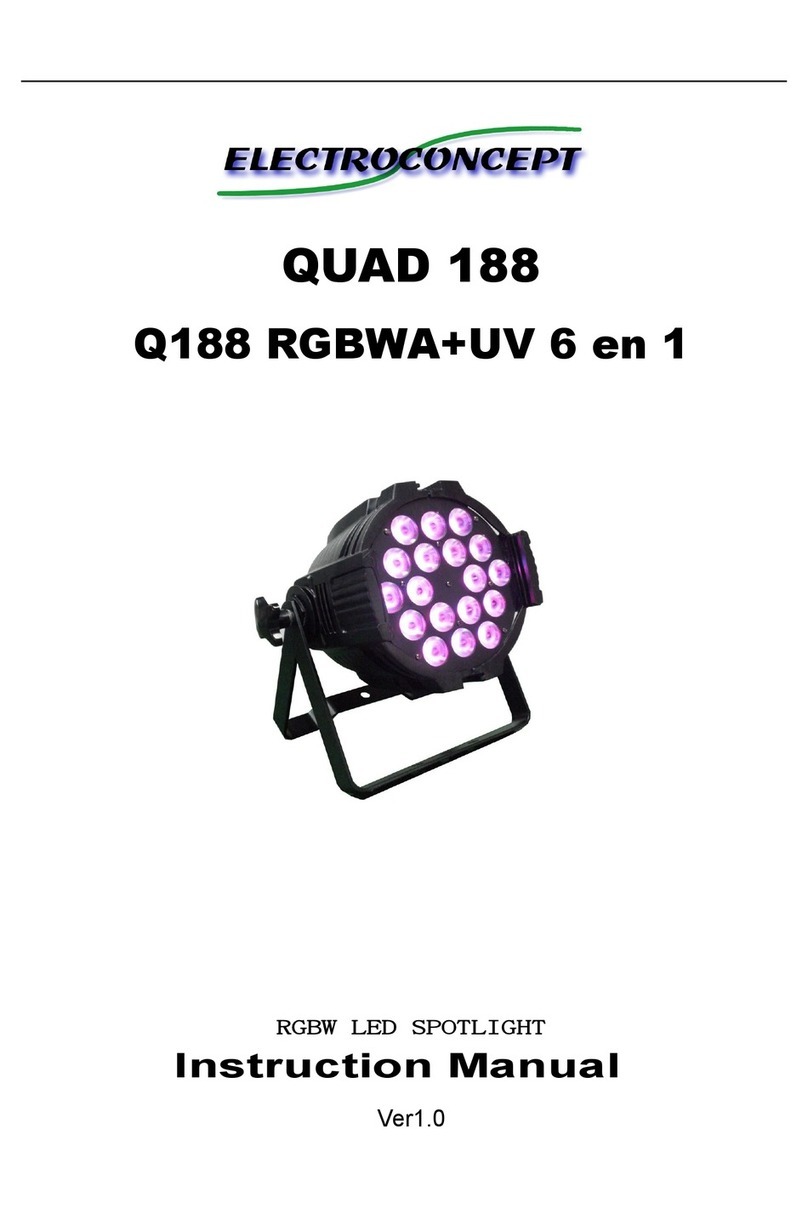
Electroconcept
Electroconcept QUAD 188 instruction manual

Foxfury Lighting Solutions
Foxfury Lighting Solutions D3060 product manual

Stanley
Stanley SL3WAKS instruction manual
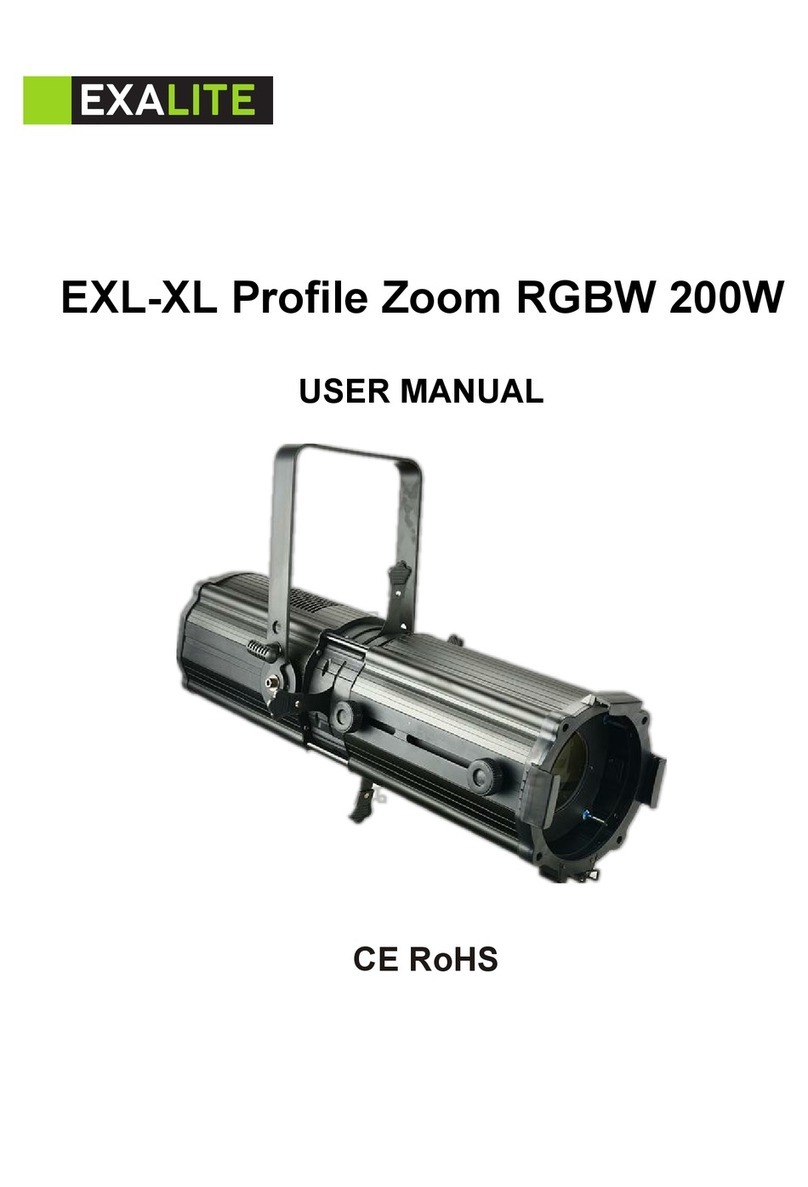
EXALite
EXALite EXL-XL Profile Zoom user manual

Pradel
Pradel BAYA Assembly
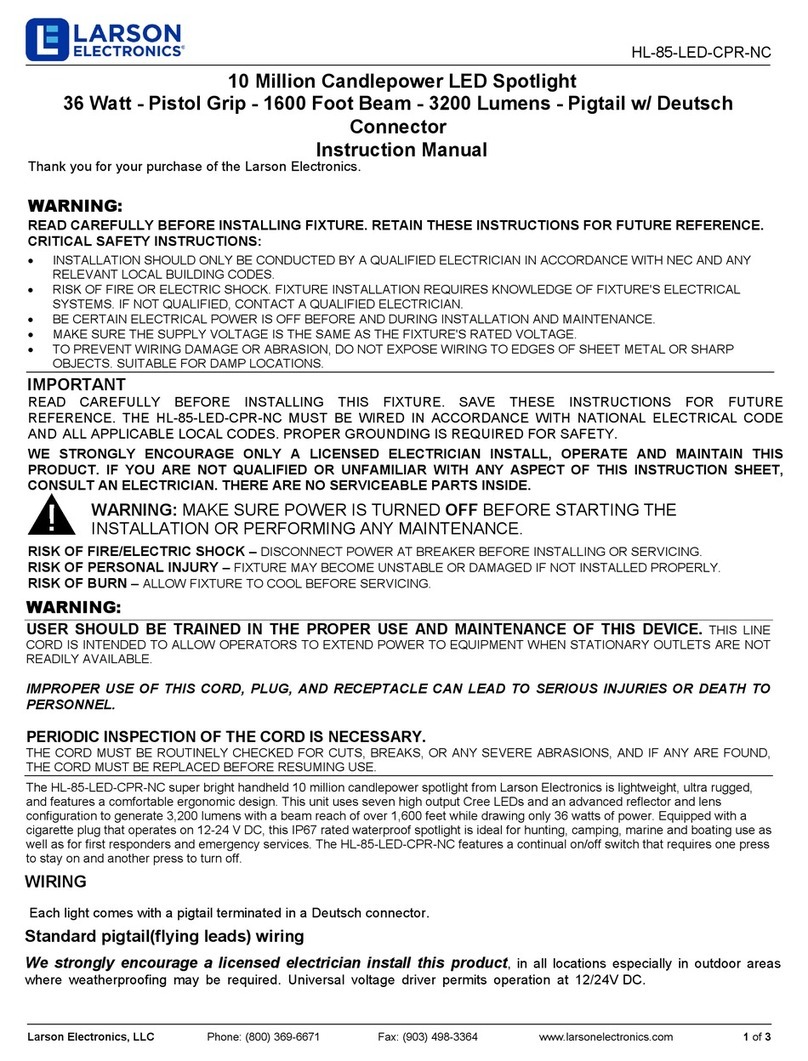
Larson Electronics
Larson Electronics HL-85-LED-CPR-NC instruction manual
